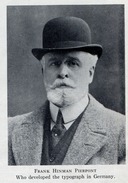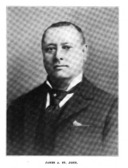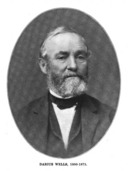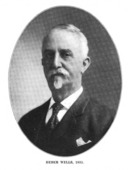As 20th century typefounding was an industrial undertaking, the roles played by those who did not themselves make punches, matrices, or types but "merely" designed the machines and managed (or owned) the manufacturing plants and matrix departments are important. Yet they remain largely unknown (with only a few exceptions, such as Barth for Cincinnati/ATF or Pierpont for English Monotype). There is of course an overlap here with Punch, Patrix and Matrix Makers and in a very few cases with Letterform Designers (e.g., Pierpont).
Until its period of decline with the advent of corporatist culture after WWII, the type industry was characterized by a remarkable number of administrators who were also competent technical people. Today the average CEO can't build anything beyond their own investment portfolio, but in the 19th century it was not unusual for a type foundry president to have started out as a practical mechanic.
So for the most part, I'll include administrators (all the way up to owners and capitalists) here. But there will be exceptions. Also, because we know so little of the daily activities of many of these people, it is certain that I've made errors of classification (or that reality breaks my classifications). For example, Morris Fuller Benton will be found here, because while he was certainly a great student of type (and thus would fit in Type Scholars and Collectors and probably also a Letterform Designer), he was trained as an engineer and excelled in the role of manager of the type-making process. By way of contrast, while Stanley Morison occupied a role at (English) Monotype which was in many ways very similar to M.F. Benton's, I've put him in Type Scholars and Collectors. This is perhaps unfair. But we're dealing here with people who had many talents and many roles; any categorization of them is bound to fail.
Especially in our own age after the demise of mainstream hot metal type there are a number of smaller type foundries owned and managed by their chief casterman. In honor of the importance, too long neglected, of the casterman, I've tended to file these people under ../ Type Casters. (Examples include Schuyler Shipley, the late Brian Hubbard, and the late John Eickhoff.)
Wood type fits poorly into my organizational scheme, largely because my own focus is on metal type. But there were strong links between the two industries. Most of the better-known figures in the wood type industry (e.g., Wells, Page, and Hamilton) are here because, as Rob Roy Kelly notes, they were businessmen who had "an inherent knack for working with machinery." ( {Kelly}, p. 49)
See also Type Scholars and Collectors for a few individuals who were in management and did influence type design, but who are better remembered as scholars, collectors, type revivalists, or printers (especially Stevens L. Watts).

[US] Edwin Allen (Wood Type)
Developed a pantograph engraving machine applied to the manufacture of wood type in 1836, two years after another pantograph engraving machine for wood type was developed by William Leavenworth. Manufactured wood type from about 1836 to 1839. Upon the dissolution of his firm, its manager, Ebenezer Russell Webb, presumably (according to Kelly) took this pantograph technology with him when he joined Darius Wells in the firm of Wells & Webb.

[US] Linn Boyd Benton
A self-taught engineer of the first order. This is a link up-and-over to his entry under Punch, Patrix, and Matrix Makers

[US] Morris Fuller Benton
The most important maker of types of the 20th century. Yes, really.
Note: For his father, Linn Boyd Benton, see the Punch, Patrix, and Matrix Makers set of Notebooks.

David Bruce Sr.
1770 - 1857 {Annenberg 1994}: 79, 81. Elder brother of George Bruce and co-founder with him of what became Bruce's New York Type Foundry. Father of David Bruce Jr., the inventor of the pivotal type caster. Retired in 1822 (with a brief return in 1824) {Annenberg 1994}: 82.
Note: See the ../ Punch, Patrix, & Matrix Makers -> Note on Bruce Genealogy for sorting out the various Bruces and the locations in these Notebooks where they appear.

George Bruce
1781-06-26 to 1866-07-05 { Geni GB}, {Annenberg 1994}: 79, 82. Younger brother of David Bruce Sr. and co-founder with him of what became Bruce's New York Type Foundry. Married Catherine Wolfe (1785-06-21 to 1861-03-18 { Geni CWB}, the daughter of "the great hardware merchant and real estate investor" John David Wolfe ({ Millionaires 1892}: 59). Father of David Wolfe Bruce. and George Wolfe Bruce
Note: See the ../ Punch, Patrix, & Matrix Makers -> Note on Bruce Genealogy for sorting out the various Bruces and the locations in these Notebooks where they appear.

David Wolfe Bruce
1824 - 1895-03-13 { Geni DWB}, {Annenberg 1994}: 82. Son of George Bruce and co-inheritor, with his brother George Wolfe Bruce of Bruce's New York Type Foundry. Annenberg says that he took over the operation of this foundry upon the death of his father in 1866. Annenberg also says that he "always fancied himself as a patron of the arts." {Annenberg 1994}: 82. He would have had the money to do so.
Note: See the ../ Punch, Patrix, & Matrix Makers -> Note on Bruce Genealogy for sorting out the various Bruces and the locations in these Notebooks where they appear.

George Wolfe Bruce
1828 - 1887-11-14. { Geni GWB}. Son of George Bruce and co-inheritor, with his brother David Wolfe Bruce of Bruce's New York Type Foundry.
Note: See the ../ Punch, Patrix, & Matrix Makers -> Note on Bruce Genealogy for sorting out the various Bruces and the locations in these Notebooks where they appear.

Conner, James
Started the United States Type Foundry (NY; various business names). Father to William Crawford Conner and James M. Conner, who continued the foundry as James Conner's Sons, and a third son, Charles S. Conner, employed by the firm.
With his employee Edwin Starr, the originator of the process of electroforming matrices.

[US] Henry H. Hardinge
Probably the same Henry H. Hardinge who co-founded Hardinge Brothers (the noted machine-tool manufacturer). With Robert Wiebking, as Wiebking, Hardinge and Company developed an in-house, unnamed type casting machine used by Wiebking, Harding & Co.'s Advance Type Foundry. Later developed a composing linecasting machine, the patent for which (US 1,131,643, issued 1915-03-09) was assigned to Chicago attorney and businessman Josiah Cratty; this machine does not appear in Huss' The Development of Printers' Mechanical Typesetting Methods: 1822-1925 and probably was not manufactured.

[US] Charles B. Ketterer
Superintendent of the Display Matrix Department of the Lanston Monotype Machine Company. Left, and in 1921 joined the newly founded Carter Type Machine Company, which was somehow associated with the Superior Matrix Company (they shared the same address).

William Leavenworth
Inventor (or co-inventor) of the first pantograph used for wood type engraving in America. In business manufacturing wood type from about 1836 to 1839. This business was managed by Ebenezer Russell Webb, who, it is presumed (by Kelly), took this pantograph technology with him when he joined Darius Wells in the firm of Wells & Webb.

[US] Ernst Lietze
[NOT DONE] Note that his name is spelled "Lietze," not "Leitze." This spelling is confirmed by his US patent applications. I have made this error myself in these pages (if you should spot an instance of it, please let me know).

[US] Richard N. McArthur
? - 1956. Typefoundry manager. With Keystone Type Foundry 1908-1913. Joined Barnhart Brothers & Spindler in 1916. Commissioned several new faces. Responsible for the revival of many 19th century faces, from original BB&S matrices but often under new names, in the 1925 BB&S Catalog No. 25. See Eckman, James. The Heritage of the Printer, Vol. 1 (Philadelphia, PA: North American Publishing Co., 1965): 119-123.

[US] Robert W. Nelson
Co-founder of the American Press Association. Purchased and expanded the Thorne Type-Setting Machine Company. Joined the board of ATF in 1894. Soon became General Manager of ATF; in 1901 became President. The guiding hand at ATF in its greatest years.

[Mostly UK] Frank Hinman Pierpont
Patent clerk in Hartford (witnessed the Paige patent). Then to Germany to promote the Rogers Typograph. Became manager of the Monotype Works in Salfords.

[US] Gustav H. Schauppner
b. [?] - d. [1872?] Co-owner (and co-founder?) of the Illinois Type Foundry. Father of Louis Schauppner
Note: Little is known about Gustav Schauppner. I've filed him here, in the "Engineers, Managers and Owners" section because he was at one time a co-owner of a type foundry and, earlier, had been in charge of ordering from German (vs. making himself) matrices for another foundry. But the lack of any evidence for practical skills does not mean that he might not have possessed them.

[US] Charles Schokmiller
1870 - ca. 1927. St. Louis, MO. For a brief time (1904-1906) an independent manufacturer of type founders' equipment. Built a pantograph matrix engraving machine which was exported in 1906 to Stephenson, Blake (UK) and used there for at least twenty years. His firm combined with a printing supply firm in 1906 to form the Western Type Foundry (which purchased the Advance Type Foundry in 1913 and was in turn purchased in 1918 by Barnhart Brothers & Spindler (by that time owned by ATF)). Founded the Laclede Type Foundry (1921-1923), which was also purchased by BB&S.

[US] Carl Schraubstadter
He is best known as the owner of the Central Type Foundry. But Maurice Annenber, in Type Foundries of America and their Catalogs refers to him as "a practical typefounder." This is confirmed by Mullen, in Recasting a Craft (2005) , which gives a brief biographical sketch.

James A. St. John
Co-proprietor of the Central Type Foundry and, later, also the Boston Type Foundry

[US] Sturdevant
The name Sturdevant is associated with two early type casting machines and their patents: that of Sturdevant & Starr in the late 1820s, and that of Mann & Sturdevant patented in 1831. The latter of these was made in reasonable numbers and employed in commercial manufacture in at least three type foundries (this before the invention of Bruce's pivotal type caster).
There is a question, however, as to the first name of Sturdevant (John or Stephen) and whether the Sturdevant associated with each of these two machines is the same individual or not.

[US] Richard Svensen
Head of the Lanston Monotype Machine Company's matrix department in (at least) the 1950s. See Hopkins, Richard L. Tolbert Lanston and the Monotype (Tampa, FL: University of Tampa Press, 2012): 143, where he reprints references to Svenson by John Anderson, including the remark that "It was his skill and knowledge that assisted in the conversion of Goudy's master drawings to the Monotype unit system."

Ebenezer Russell Webb
Manager of the wood type business of William Leavenworth. When Leavenworth's firm dissolved, he joined Darius Wells in the partnership Wells & Webb. It is presumed (by Kelly) that he brought with him Leavenworth's pantograph engraving machine for wood type. David Bruce, Jr. may have assisted in this (see {Kelly}, p. 43).
NOTE: To the best of my knowledge, there is no family connection between the wood type manufacturers Darius and Heber Wells, on the one hand, and the Cincinnati type founders Oliver, Horace, Lemuel T., and Charles Wells on the other hand.

[US] Charles Wells
A principal in the Cincinnati Type Foundry after the departure of Lemuel T. Wells at the outset of the Civil War. Grandson of Oliver Wells I'm not yet certain of Charles Wells' relationship to Oliver's son Horace Wells, or to his own predecessor at the Cincinnati Type Foundry, Lemuel T. Wells. Bullen (Discursions No. IV, Inland Printer Vol. 38, No. 1 (Oct. 1906), p. 36) says that Charles was the son of Horace, but nothing that Bullen says can be accepted as true without independent confirmation. Died 1885.

[US] Darius Wells (Wood Type)
The "founder" of the wood type industry in America. Developer of a "lateral router" (not yet pantographically controlled) for making wood type. Left the type business in 1856.

[US] Heber Wells (Wood Type)
Son of Darius Wells. Re-purchased the successor to his father's business in 1864.

[US] Horace Wells
Son of Oliver Wells. Active in the Cincinnati Type Foundry from 1817 through the mid-1830s, and again in the 1840s through his death by gun violence in 1851.

[US] Lemuel T. Wells
Ran the Cincinnati Type Foundry after the death of Horace Wells. Left the foundry at the start of the Civil War.

[US] Oliver Wells
Worked for Elihu White. Founded the Cincinnati Type Foundry for White. Father of Horace Wells. See Annenberg's entry on the Cincinnati Type Foundry.

[US] Elihu White
Founded the White's Type Foundry Had an important place in the history of type caster development.

[US] George H. Ziegler
Designed the space and quad casting machines used first by MacKellar, Smiths and Jordan. Later improved the Barth Type Caster for American Type Founders Co.
{Annenberg 1994} Stephen O. Saxe [additions, intro], Elizabeth K. Lieberman [index]. Type Foundries of America and their Catalogs New Castle, DE: Oak Knoll Press, 1994.
{Geni CWB} Entry for Catherine Bruce (Wolfe) at Geni.com website: https://www.geni.com/people/Catherine-Bruce/6000000011334973727
Please note that these genealogical website references are secondary (tertiary, really) sources. I haven't yet tracked down this information to primary sources. They must be treated as provisional pending verification.
{Geni DWB} Entry for David Wolfe Bruce at Geni.com website: https://www.geni.com/people/David-Bruce/600000001133569646
{Geni GB} Entry for George Bruce at Geni.com website: https://www.geni.com/people/George-Bruce/6000000011335401350
{Geni GWB} Entry for George Wolfe Bruce at Geni.com website: https://www.geni.com/people/George-Bruce/6000000011335321355
{Millionaires 1892} The Tribune Monthly. Vol. 4, No. 6 (June 1892). Issue subject: "American Millionaires: The Tribune's List of all Persons in the United States Reputed to be Worth a Million or More."
Digitized by Google from an unknown library's copy, Google Books ID: wJFOAQAAMAAJ.
All portions of this document not noted otherwise are Copyright © 2012 by David M. MacMillan and Rollande Krandall.
Circuitous Root is a Registered Trademark of David M. MacMillan and Rollande Krandall.
This work is licensed under the Creative Commons "Attribution - ShareAlike" license. See http://creativecommons.org/licenses/by-sa/3.0/ for its terms.
Presented originally by Circuitous Root®